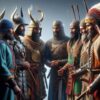Armored Assault: Engaging in Mechanized Warfare
In the theater of mechanized warfare, armored vehicles serve as the vanguards of military might, dominating the battlefield with their firepower, mobility, and protection. “Armored Assault: Engaging in Mechanized Warfare” is a comprehensive guide that delves into the intricacies of armored warfare, exploring the tactics, techniques, and technologies that define this dynamic and lethal form of combat. From tanks and armored personnel carriers to artillery and reconnaissance vehicles, this guide provides invaluable insights for commanders and crews who seek to master the art of armored assault on the modern battlefield.

Part 1: Understanding Armored Warfare
The Evolution of Armored Warfare
Armored warfare has undergone a remarkable evolution since its inception, from the lumbering behemoths of World War I to the lightning-fast armored thrusts of modern conflicts. Commanders must understand the historical context and technological advancements that have shaped armored warfare over the years, informing their tactics and strategies for contemporary battles.
The Role of Armored Vehicles
Armored vehicles play a multifaceted role on the battlefield, serving as mobile platforms for firepower, protection, and maneuverability. Tanks are the backbone of armored warfare, leading armored assaults with their formidable firepower and heavy armor. Armored personnel carriers transport infantry troops safely across the battlefield, while reconnaissance vehicles gather vital intelligence and artillery vehicles deliver devastating firepower from afar.
The Principles of Combined Arms
Combined arms is the cornerstone of effective armored warfare, integrating armored vehicles with infantry, artillery, and air support to achieve maximum combat effectiveness. Commanders must coordinate the actions of different combat arms, leveraging their unique capabilities to create synergistic effects that overwhelm the enemy and seize the initiative on the battlefield.
Part 2: Mastering Armored Tactics
Fire and Maneuver
Fire and maneuver is a fundamental tactic used by armored units to outmaneuver and outgun the enemy. Tanks and other armored vehicles provide covering fire while infantry troops advance under their protection, seizing key objectives and securing the battlefield. Fire and maneuver tactics require coordination, communication, and decisive action to achieve success against enemy forces.
Exploiting Terrain
Terrain plays a crucial role in armored warfare, offering opportunities for concealment, cover, and maneuver. Commanders must analyze the terrain and exploit its features to their advantage, using hills, forests, and urban areas to shield their movements and ambush enemy forces. By understanding the terrain and adapting their tactics accordingly, armored units can gain a decisive edge over their adversaries.
Shock and Awe
Shock and awe tactics are designed to overwhelm the enemy with overwhelming firepower and speed, striking swiftly and decisively to disrupt their defenses and sow chaos in their ranks. Armored units excel at shock and awe tactics, using their mobility and firepower to punch through enemy lines and create gaps in their defenses. By maintaining momentum and keeping the pressure on the enemy, armored units can achieve decisive victories on the battlefield.
Part 3: Crew Training and Readiness
Crew Proficiency
Crew proficiency is essential for maximizing the combat effectiveness of armored vehicles on the battlefield. Commanders must invest in comprehensive training programs that develop the skills and capabilities of their crews, ensuring they are proficient in operating, maintaining, and repairing their vehicles under the most challenging conditions. Crew proficiency enables armored units to perform their missions with precision and confidence, even in the heat of battle.
Tactical Readiness
Tactical readiness is the ability of armored units to deploy rapidly and effectively in response to emerging threats or operational requirements. Commanders must maintain high levels of tactical readiness, conducting regular training exercises and rehearsals to hone their unit’s capabilities and maintain operational readiness. Tactical readiness ensures that armored units can respond rapidly to crises and seize opportunities on the battlefield with speed and decisiveness.
Adaptive Thinking
Adaptive thinking is essential for armored commanders and crews to anticipate and respond effectively to changing battlefield conditions and enemy tactics. Commanders must encourage a culture of innovation and adaptability within their units, empowering crews to think creatively and adapt their tactics to overcome evolving threats. Adaptive thinking enables armored units to maintain the initiative and outmaneuver their adversaries, even in the face of uncertainty and adversity.


